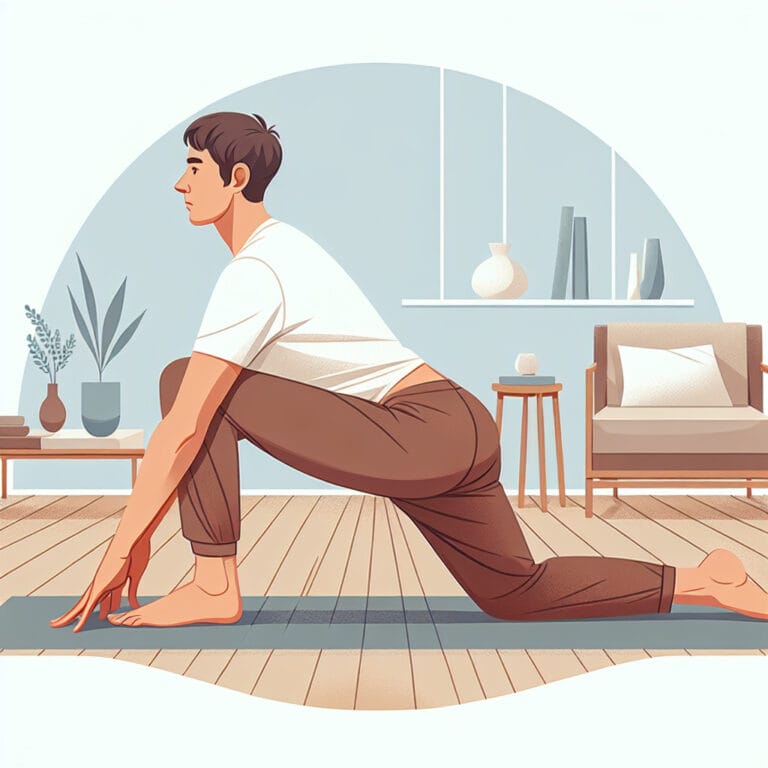
Top Yoga Poses Effective for Piriformis Syndrome Relief
Table of Contents
- Introduction
- Understanding Piriformis Syndrome
- The Role of Yoga in Piriformis Syndrome Relief
- Top Yoga Poses for Piriformis Syndrome Relief
- Conclusion
- Frequently Asked Questions
Introduction
Piriformis Syndrome is a painful condition where the piriformis muscle, located in the buttocks near the top of the hip joint, spasms and causes discomfort in your lower back and hips. What’s more, this disruption can lead to sciatic pain as the piriformis muscle tends to irritate the nearby sciatic nerve. This syndrome becomes a chronic pain issue for many due to its impact on basic functions like walking or sitting.
However, incorporating yoga into your routine can provide much-needed relief from this condition. How? Yoga poses are designed to stretch and strengthen muscles – in this case, focusing on the piriformis muscles and other related areas like gluteus maximus and hip girdle. It’s not just about physical benefits; taking steady deep breaths during yoga practice also promotes relaxation which indirectly aids pain reduction.
Consider trying out Yin Yoga, an excellent style for beginners that targets deep connective tissues between muscles with longer-held poses promoting external rotation of hip joints. Forward bend or forward fold types of yoga poses would especially benefit those struggling with Piriformis Syndrome by creating space around sacroiliac joint – where your spine meets your pelvis.
Remember, every individual is different and might respond differently to each type of pose. Therefore it’s crucial that yogis work with experienced yoga teachers who understand specific needs related to Piriformis Syndrome relief. As you continue practicing these beneficial postures over time – remember consistency is key here- you’ll notice improvement in managing symptoms of Piriformis Syndrome including lower back pain, improving overall quality of life.
Understanding Piriformis Syndrome
Piriformis Syndrome is an under-recognized cause of lower back and hip pain, a condition often mistaken for other common ailments. The primary culprit behind this syndrome is the piriformis muscle, a significant external rotator situated deep within your gluteus maximus – in fact, it’s nestled right above where the sciatic nerve runs through. When this muscle tightens or spasms, it presses onto the nearby sciatic nerves, triggering what we call ‘sciatica’ – a health problem that manifests as radiating leg pain originating from the lower back.
This muscle-based malady finds its roots in various scenarios such as prolonged sitting, squatting too frequently or improperly, running with improper footwear or on uneven surfaces. Sometimes even direct trauma to the buttocks can result in Piriformis Syndrome.
As for recognizing Piriformis Syndrome symptoms – apart from chronic pain which tends to surge while performing simple actions like getting up from a chair or walking upstairs – you might notice numbness and tingling sensations down your leg. Moreover, there’s something called ‘piriformis sign’, where externally rotating your hip socket while lying on your back causes discomfort around outer hip area indicating possible Piriformis Syndrome.
While dealing with these myriad symptoms might seem overwhelming, practicing specific type yoga poses extends towards relief by targeting piriformis muscles directly. Regularly practicing styles like Yin Yoga not only helps increase flexibility but also strengthens pelvic girdle muscles and reduces tension around sacroiliac joint leading to decreased irritability of sciatic nerves over time. Therefore yoga teachers suggest yogis begin incorporating forward fold and forward bend energetic into their routines gradually progressing towards more complex poses based on individual body response.
| Understanding Piriformis Syndrome |
|---|
| Piriformis Syndrome is an under-recognized cause of lower back and hip pain, often mistaken for other common ailments. It is caused by the piriformis muscle, which is situated deep within the gluteus maximus, pressing onto the nearby sciatic nerves when it tightens or spasms. This is known as ‘sciatica’ and manifests as radiating leg pain originating from the lower back. |
| Prolonged sitting, squatting too frequently or improperly, running with improper footwear or on uneven surfaces, or even direct trauma to the buttocks can result in Piriformis Syndrome. |
| Symptoms of Piriformis Syndrome include chronic pain, numbness and tingling sensations down your leg. You might also notice the ‘piriformis sign’, where externally rotating your hip socket while lying on your back causes discomfort around the outer hip area. |
| Practicing specific types of yoga poses can provide relief by targeting the piriformis muscles directly. Regular practice of styles like Yin Yoga can increase flexibility, strengthen pelvic girdle muscles, and reduce tension around the sacroiliac joint, leading to decreased irritability of the sciatic nerves over time. |
The Role of Yoga in Piriformis Syndrome Relief
An expert in the field once stated, “Yoga is not a cure-all. However, it carries immense potential for alleviating chronic pain conditions like Piriformis Syndrome.” Indeed, yoga poses target the piriformis muscles directly, stretching and strengthening them, all while fostering external rotation of hip joints. This results in reduced tension around the sacroiliac joint – where your spine meets your pelvis – an area significantly impacted by this syndrome. Yin Yoga’s forward fold poses are particularly beneficial as they create space around this joint.
But how does practicing these type yoga poses provide relief from lower back pain or hip pain? The answer lies in their capacity to gradually decrease the irritability of sciatic nerves that get inflamed due to pressure from a spasming piriformis muscle – an external rotator lying deep within gluteus maximus where the sciatic nerve runs through.
Yoga goes beyond physical benefits; taking steady deep breaths during practice promotes relaxation and indirectly aids pain reduction. It’s no surprise then that many suffering from chronic conditions like Piriformis Syndrome turn towards these ancient postures for relief. Starting with beginners energetics like forward bend styles and progressively incorporating more complex postures based on individual body response can help manage symptoms effectively over time.
A surprising fact echoes through the experiences of numerous yogis: Regular yoga practice not only brings about a noticeable improvement in managing symptoms but also boosts overall quality of life by improving flexibility and strengthening pelvic girdle muscles surrounding hip socket area contributing to long-term wellness. While dealing with discomfort may feel overwhelming initially, remember that each stretch and pose is a step towards healing and renewed vitality.
Top Yoga Poses for Piriformis Syndrome Relief
A surprising fact is that the pigeon pose, a staple in many yoga routines, serves as an excellent exercise for those seeking piriformis syndrome relief. This pose targets the hip rotators and flexors, helping stretch out tight piriformis muscles and reduce sciatic pain caused by an inflamed sciatic nerve running through the muscle. The position involves bending one knee forward while extending your other leg behind you, creating a deep stretch in your glutes. Grab onto your back foot to increase the stretch if comfortable – but remember to maintain controlled breathing throughout.
Supine twist is another beneficial yoga type which involves lying on your back with arms extended outward at shoulder level. Bring one knee across the body while keeping both shoulders grounded, promoting rotation of lower back and stretching of gluteus maximus – all contributing towards relieving hip pain associated with Piriformis Syndrome.
Seated forward bend provides essential stretches for individuals suffering from chronic pain due to piriformis syndrome. By reaching forward from a seated position while maintaining divine alignment of spine, this pose lengthens lower back muscles and eases tension around hip socket area further providing relief through external rotation.
Cow face pose or ‘Gomukhasana’ encourages beneficial external rotation of hip joints by stacking knees while sitting upright creating opening around outer hips – easing discomfort related to Piriformis Syndrome over time.
Lastly, reclining Hand-to-Big-Toe Pose requires yogi’s lying flat on their backs extending one leg up into air holding big toe aiding in releasing pressure off sacroiliac joint where spine meets pelvis thereby reducing lower back pain commonly experienced amongst those dealing with Piriformis Syndrome.
Each of these poses offers unique benefits when integrated into regular routines under guidance from experienced yoga teachers specially trained in such therapeutic styles paving way towards long-term wellness.
Conclusion
Consider this: your journey towards piriformis syndrome relief lies in the form of simple yoga poses. Through targeting the external rotator, namely the piriformis muscles, these type yoga poses significantly alleviate lower back pain and hip discomfort. How? By virtue of external rotation of hip joints and by reducing tension around sacroiliac joint. The importance of yin yoga in this context cannot be undermined; forward fold or forward bend styles specifically are potent tools for extending beneficial stretches to areas affected by chronic pain due to Piriformis Syndrome. As you immerse yourself into consistent practice under expert guidance from experienced yoga teachers, not only will sciatic pain subside but an amelioration in overall health will ensue – a testament to how profound taking steady deep breaths during each pose can be! And remember, whether you’re a novice or seasoned yogi, your path towards relief from piriformis syndrome pain can begin with understanding which style of benefit yoga poses best serves your individual needs.



